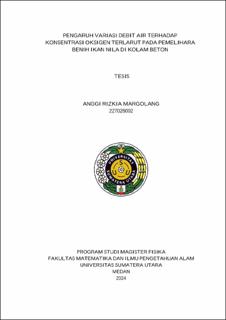Pengaruh Variasi Debit Air terhadap Konsentrasi Oksigen Terlarut pada Pemelihara Benih Ikan Nila di Kolam Beton
The Effect of Water Flow Rate Variation on Dissolved Oxygen Concentration in The Rearing of Nile Tilapia in Concrete Ponds

Date
2024Author
Margolang, Anggi Rizkia
Advisor(s)
Nasution, Tulus Ikhsan
Wahyuningsih, Hesti
Metadata
Show full item recordAbstract
This study aims to analyze the effect of water flow rate variations on dissolved
oxygen (DO) concentration and survival rate of Nile tilapia (Oreochromis niloticus)
in concrete ponds. Three treatments were employed: no pump, pump with a flow rate
of 1200 L/h, and pump with a flow rate of 1800 L/h. Measurements were conducted
over five days with three observation sessions (morning, afternoon, and evening) for
each treatment. The results show that using a pump with a flow rate of 1200 L/h
resulted in stable DO concentrations ranging from 5-7 ppm and a higher survival rate
of fish, specifically 95%, compared to treatments without a pump (70%) and with a
pump at 1800 L/h (85%). Correlation analysis indicates a significant positive
relationship between water flow rate and dissolved oxygen concentration, with the
1200 L/h flow rate achieving an optimal balance between water circulation and
turbulence. Other water quality parameters such as temperature and pH were also
monitored and indicated optimal conditions for Nile tilapia growth. This study
recommends the use of a pump with a flow rate of 1200 L/h for Nile tilapia
aquaculture in concrete ponds to achieve optimal results and production
sustainability.
Collections
- Master Theses [310]
